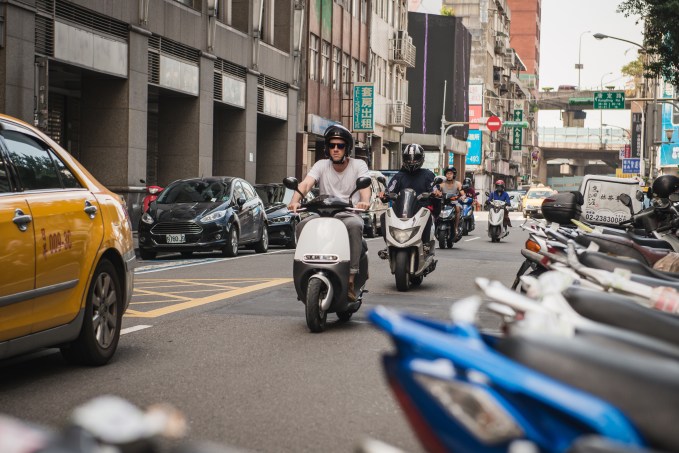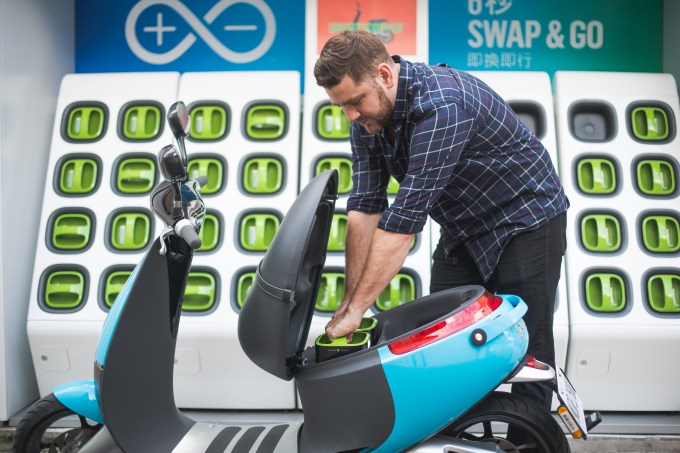Since the launch of its first electric scooter in 2015, Gogoro co-founder and CEO Horace Luke has frequently been asked when the startup is going to expand beyond Taiwan. In its home country, Gogoro’s two-wheel vehicles, with their distinctive swappable battery system, are now the top-selling electric scooters.
But Luke says the company has always seen itself as a platform company, with the ultimate goal of providing a turnkey solution for energy-efficient vehicles. Now with the launch of GoShare*, its new vehicle-sharing platform, and partnerships with manufacturers such as Yamaha, Gogoro is ready to go global.
Founded by Luke, HTC’s former chief innovation officer, and chief technology officer Matt Taylor in 2011, Gogoro develops most of its technology in-house, including scooter motors, telematics units, backend servers and software. GoShare’s pilot program will launch next month in Taoyuan City, where Gogoro’s research and development center is located, with the goal of expanding with partners into cities around the world over the next year, starting in Europe, Australia and Southeast Asia.
“Gogoro has always been out with a thesis that we will be a platform enabler,” Luke told Extra Crunch during an interview in the company’s Taipei City headquarters. “Now you’ve seen the transformation of the company. Doing something this big, like what Gogoro is doing, takes time.”
Since the release of Gogoro’s first Smartscooter in 2015, the company says it has become the best-selling brand of electric two-wheel vehicles in Taiwan, holding a 17 percent share of the country’s vehicle market, including gas vehicles.
Last year, the company began licensing its technology to manufacturers Yamaha, Aeon and PGO to produce scooters that run on Gogoro’s batteries and charging infrastructure. It also has a partnership with Coup, the European electric-scooter sharing startup that plans to increase its fleet to more than 5,000 scooters on the streets of Paris, Berlin, Madrid and Tübingen this year, and is seeking similar deals with other vehicle-sharing services, as well as local governments that want to reduce traffic and pollution (the GoShare pilot program is being launched in collaboration with Taoyuan City’s government).
GoShare’s platform is meant to be a “very robust and cost-effective, very worry-free solution for municipalities and entrepreneurs,” Luke says. Parts of the system can be licensed separately or packaged as a turnkey solution that can be deployed in as little as two weeks.
The company describes GoShare as a “mobility solution.” When asked if this means the platform can be used for other electric vehicles, including cars, Luke says “just think of us as batteries and a motor.”
“It’s just like computers and processing ram,” he adds. “It can be any form factor. It just happens to be that the two-wheel form factor is the one we’re working on and focusing on at the moment.”
Focusing on infrastructure
Electric vehicles still hold just over two percent of market share in the U.S. and there is still a lot of work to be done creating an infrastructure that can support their wider use. One of the biggest challenges is the potential impact of electric vehicles on the electrical power grid, a problem Luke hopes Gogoro’s swappable modular batteries will help solve.
Called the Gogoro Network, battery exchange infrastructure includes GoChargers, small chargers about the size of a step stool meant for personal use, and larger ones called GoStations, located at gas stations, retail stores and other locations. Gogoro’s batteries, about the size of a shoebox, can be removed from their chargers and slide into scooters in a few seconds.
“If everybody goes home at the same time, charges their vehicles at the same time, while the family cooks, and turns on their microwave and TVs at the same time, we have a problem,” he says. “But charging batteries and letting consumers swap batteries is the only way we can offset the demand on the grid.”
Gogoro batteries may fix other barriers to electric vehicle adoption, including the cost of batteries and range anxiety, or driver concern that their vehicle will run out of power before they reach their destination, or at least another charging station. They also mean that if better batteries come out, Gogoro owners don’t need to worry about getting a new one installed.
“Most people don’t know where to recycle their cell phone batteries, never mind a huge battery from a vehicle,” Luke says. “That’s a burden in itself and worrying about that prohibits a lot of people from making a purchase decision.”
Luke grew up in Seattle and after a long absence from Taiwan, returned for a visit and was immediately struck by the density of traffic in Taipei City. The country has the highest density of scooters in the world, according to the Japan Automobile Manufacturers Association.
When describing the city to his mother, Luke told her to “imagine snorkeling and you have a whole bunch of a fish in front of you, but they are not fish, they’re scooters.” He was also surprised by how much pollution the small two-wheel vehicles produce.
“Two-wheeler pollution is really affecting people’s lives on the street,” he says. “You’re sitting behind someone who is riding a scooter. It is hot, it is polluted, it is poisonous and the exhaust is continuously blowing into your face.”
Luke says he first thought Gogoro would focus on artificial intelligence-based solutions for things like energy management and mobility. When he began researching motors, however, Luke discovered he couldn’t find one that met his specifications with the power density he wanted.
“Taiwan has the largest amount of manufacturers for high-performance motors, for appliances, blenders, hairdryers, whatever,” Luke says. “All these very experienced motor makers told me it was not possible.”
Gogoro hired a team to build its own motor, then ended up hiring another group to work on the robotics that wind it. Eventually, Gogoro also began to focus on the mopeds’ computers and electronic components, and developing its own software for the vehicles, their drivers and its retail stores.
One of the reasons Gogoro wanted to focus on creating a vehicle-sharing platform is because people in different places have different relationships with their vehicles. In some markets, like Taiwan, owning a moped is standard, while in other places two-wheeled vehicles are seen as a novelty.
In many cities, people prefer to borrow vehicles instead of dealing with the hassles of ownership. Many vehicle-sharing services rely on third-party providers and manufacturers to piece together their platforms, which Luke says creates expensive operational challenges.
“You have to buy the telematics unit from someone and the vehicle from someone else, then you have to license the management server and write your own proprietary app on top of that,” Luke said. “Then you take this hodgepodge, glued-together solution and try to go to market as fast as you can and see if you can grab ridership.”
With the launch of GoShare’s platform, Luke says he views Gogoro as a potential partner—or enabler, rather—for vehicle manufacturers (like Yamaha) and service providers like Coup. What Gogoro’s platform can offer is more efficiency. Its individual modules, including telematics units, fleet management software and learning servers, can be licensed separately, but Gogoro prefers to offer it as a full-stack solution.
“We would like to fold it into a vertical solution. We’re totally flexible, but it’s a speed versus flexibility question, and we think we will focus on speed,” he says. Gogoro’s ultimate goal is to be able to fulfill orders from partners, including vehicles, technology licensing and software licensing, in less than a week.
Finding the right time to go forward
Luke says he did not want Gogoro to expand beyond Taiwan until its turnkey solution was ready. The company is currently getting ready to enter more markets “very, very soon,” Luke says, and making key hires for its leadership team.
“The good part of being in Taiwan is that we have some great ability to engineer products,” he adds. “We have people who are so used to two-wheelers, that it is the harshest environment for us to be in because the pricing is so competitive. Taipei is a basin, so there are hills on all sides. The number one enemy of electric vehicles is hills and heat. The environment is also flooding all the time, there is acid rain all the time. We have consumers who are all very spoiled. So it’s harsh and the domestic market is tiny. It’s not a sizable market, but I look at it as waiting for the right moment.”
 Luke’s previous experience working on smartphones and personal computers taught him the value of timing, he says. Before founding Gogoro, Luke created branded products for HTC as its chief innovation officer.
Luke’s previous experience working on smartphones and personal computers taught him the value of timing, he says. Before founding Gogoro, Luke created branded products for HTC as its chief innovation officer.
Prior to joining HTC, he worked at Compaq and then Microsoft. While at Compaq in the late 1990s, Luke helped design a handheld computer with a touchscreen.
Then at Microsoft, he worked on the GoPC, a four-inch tablet with a touchscreen and Wi-Fi that ran on a Windows 2000 kernel and was patented in 2004. The devices presaged the mobile revolution, but they didn’t come at the right moment.
“Both those lessons were that they were ready way too early, even though the market was compelling,” says Luke. “The connectivity wasn’t ready, or consumer behavior wasn’t ready, or the chipset wasn’t ready, or the cost of memory.”
He notes that Porsche’s first car, the 1898 P1 (also known as the Egger-Lohner), was an electric vehicle, but the higher energy density of gas won over the batteries that were then available. But just as memory became cheaper and processors faster, battery and motor technology have developed to the point where the market is ready for electric vehicles.
“Thanks to Tesla, and thanks to general interest within the four-wheel market, every consumer knows about the fact that electric vehicles are possible, it’s not an impossibility,” says Luke. “The market is ready and the next thing is that the price is ready.”
The company now has 2,000 employees, having added 200 over the past year, and is currently working on new projects based on mobility, energy sharing and reducing pollution. Gogoro’s investors include Temasek, Sumitomo Corporation, Panasonic, the National Development Fund of Taiwan and Generation, the sustainable tech investment fund led by former vice president Al Gore. It has raised a total of $482 million in equity funding, with its last round a Series C in 2017 (Luke didn’t divulge if Gogoro plans to raise more for its expansion goals, but added “never say never” about future rounds).
Gogoro’s ultimate goal is to become a combination of Intel, Microsoft and Qualcomm, providing different platform solutions for electric vehicles and energy management, Luke says. “If you look at all the stuff that we’re working on, all the projects, they all come back to the same thesis: how do we transform cities?”
*Gogoro’s GoShare is not related to the San Diego-based logistics company of the same name.

